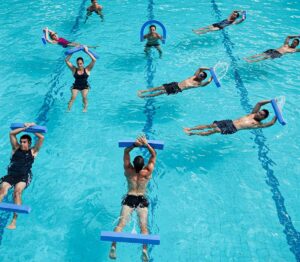Physical fitness is fundamental for maintaining overall health and well-being. It encompasses various activities designed to enhance physical strength, endurance, and flexibility. Among the myriad of exercise options, swimming and traditional gym workouts stand out as two prominent choices available to fitness enthusiasts. Both methods offer unique advantages and appeal to a diverse audience based on individual preferences, fitness goals, and health conditions.
Swimming, a low-impact aerobic exercise, is performed in water. It has ancient roots, with evidence indicating that it was practiced as early as 2000 BC. Over the centuries, it has evolved into both a recreational activity and a competitive sport. Swimming provides a full-body workout, engaging major muscle groups while reducing the risk of injuries, making it suitable for individuals of all ages. The buoyancy of water allows for natural movement without putting excessive stress on the joints, a significant consideration for those with physical limitations.
In contrast, traditional gym workouts encompass a broad range of activities, including weightlifting, aerobic exercise, and group fitness classes. The concept of gym workouts developed significantly with the advent of fitness culture in the 20th century. Gyms often provide specialized equipment that allows individuals to tailor their workouts to specific fitness objectives. Traditional gym workouts are easily accessible and cater to those who prioritize strength training, cardiovascular health, and muscle toning. This form of exercise can accommodate diverse preferences, ranging from high-intensity interval training (HIIT) to yoga or Pilates classes.
The rising interest in overall wellness, particularly in the context of modern lifestyles, has led to the increasing popularity of both swimming and gym workouts. Each activity offers distinct benefits and engages individuals differently, appealing to a wide range of fitness enthusiasts. Understanding these two approaches provides a foundation for a comparative analysis of their respective advantages and suitability for achieving fitness goals.
Benefits of Swimming as a Workout
Swimming has long been recognized as a highly effective form of exercise, boasting numerous advantages that contribute to overall health and fitness. One of the primary benefits of swimming is its low-impact nature. Unlike many traditional gym workouts that exert significant stress on the joints, swimming provides a buoyant environment that minimizes impact, making it suitable for individuals of all ages and fitness levels, including those recovering from injuries.
Furthermore, swimming is an excellent calorie-burning activity. Studies indicate that swimming can burn anywhere from 400 to 700 calories per hour, depending on the intensity and the swimmer’s weight. This significant calorie expenditure contributes to weight management and promotes fat loss, making swimming an attractive option for those looking to shed excess weight. The varying strokes involved in swimming not only engage multiple muscle groups but also enhance muscle toning throughout the body. Each stroke targets different areas, ensuring a well-rounded workout that builds strength and improves muscle definition.
Additionally, swimming is known to provide substantial cardiovascular benefits. As an aerobic exercise, swimming enhances heart and lung efficiency, which can lead to a reduction in the risk of heart disease and improved overall cardiovascular health. Regular swimmers often report improved stamina and endurance, leading to better performance in other physical activities as well.
Another key benefit is the stress relief that swimming offers. The soothing properties of water can mitigate tension and anxiety, creating a sense of relaxation that is often lacking in more intense gym environments. Testimonials from swimmers frequently emphasize the mental health aspects of this activity, highlighting its positive impact on overall well-being.
In conclusion, swimming offers a myriad of benefits that make it a superior workout choice for many. From its low-impact qualities to its effectiveness in burning calories and toning muscles, swimming supports a healthy lifestyle and enhances both physical and mental health.
Advantages of Traditional Gym Workouts
Traditional gym workouts have long been a staple in the fitness community, providing numerous advantages that cater to individuals seeking to enhance their physical health and overall well-being. One of the primary benefits of engaging in workouts at a traditional gym is the opportunity for muscle building. Weight training, a core element of gym regimes, effectively promotes muscle hypertrophy and strength development. Resistance exercises using free weights or machines not only help to increase lean muscle mass but also improve metabolic efficiency.
Another significant aspect of gym workouts is the variety of equipment available. Gyms typically offer a wide range of machines, free weights, and functional training tools that allow individuals to target specific muscle groups. This diversity in equipment facilitates customization of workout programs, ensuring members can continue challenging themselves and achieving their fitness goals. Furthermore, the versatility of gym environments encourages users to diversify their routines, integrating both aerobic and anaerobic exercises.
Flexibility is an essential factor as well; many gyms provide access to classes that include yoga, Pilates, and high-intensity interval training (HIIT). These classes not only enhance flexibility and mobility but also promote cardiovascular health and general fitness. Additionally, the convenience of a gym setting cannot be overstated. With numerous locations and operating hours, individuals can easily fit workouts into their busy schedules.
Moreover, the option for personal training services is a considerable advantage. Qualified personal trainers can provide tailored workout plans and expert advice, ensuring individuals maximize their effort and achieve optimal results. This personalized approach often leads to improved motivation and adherence to fitness goals. As such, traditional gym workouts present a robust framework for developing strength, flexibility, and overall physical health.
Physical and Mental Health Benefits Compared
Both swimming and traditional gym workouts offer significant advantages for physical and mental health, but they do so in divergent ways. Swimming is a low-impact exercise that engages almost all muscle groups, making it an excellent choice for building strength, enhancing cardiovascular fitness, and promoting flexibility. This holistic approach to fitness often results in improved body composition and endurance, which can contribute to overall physical health. In contrast, traditional gym workouts, which may include weightlifting, cardiovascular machines, and group classes, can allow for targeted muscle development and strength gains, enhancing specific fitness levels tailored to individual goals.
On the mental health front, both swimming and gym workouts provide valuable stress relief. Engaging in physical activity releases endorphins, commonly known as “feel-good” hormones, which can alleviate feelings of anxiety and depression. Swimming, with its rhythmic strokes and soothing water environment, is particularly effective in fostering a meditative state, promoting relaxation, and enhancing overall mood. Gym environments, however, can offer social interaction through group classes and personal training sessions, which may cultivate a sense of community and support that is beneficial to mental well-being. This camaraderie can be a motivating factor for many individuals, encouraging them to maintain a consistent workout schedule.
Additionally, swimming is often perceived as a solitary activity, while gym workouts can provide interpersonal connections through group exercises or gym memberships. This distinction leads to varying psychological benefits. For some, the environment of a gym enhances engagement due to shared goals and motivation, while others may find solace in solitary swimming sessions that offer a personal retreat from daily stressors. Ultimately, the choice between swimming and traditional gym workouts hinges on individual preferences, but both offer unique contributions to enhancing physical health and bolstering mental well-being.
Caloric Burn: Swimming vs. Gym Workouts
When considering the benefits of aquatic exercise versus traditional gym workouts, an important aspect to evaluate is the caloric expenditure associated with each activity. Swimming is renowned for its full-body engagement, which can lead to significantly higher caloric burn rates compared to some gym-based exercises. For instance, the average person weighing around 155 pounds can burn approximately 400-500 calories per hour while swimming freestyle vigorously. In contrast, performing moderate gym exercises such as weightlifting or moderate cardio typically results in a caloric burn of about 200-300 calories in the same duration.
The caloric burn during swimming varies significantly depending on the stroke performed. For example, competitive strokes like butterfly or freestyle can lead to caloric expenditures on the higher end of the scale, whereas backstroke and breaststroke may yield lower caloric burn. On the other hand, gym workouts can range widely in their caloric expenditures based on the type of exercise, intensity, and body weight of the individual. High-intensity interval training (HIIT), for example, can match or even exceed some swimming strokes, burning approximately 500-800 calories in an hour for the same individual.
Several factors influence caloric burn in both settings, including body weight, the duration of the workout, and the energy exertion level. Heavier individuals tend to burn more calories regardless of the activity performed, while the intensity of workouts plays a crucial role in maximizing caloric expenditure. Monitoring heart rates and perceived exertion can provide insights into the effectiveness of a workout. Overall, while both swimming and gym workouts can be effective for caloric burn, swimming often provides a comprehensive full-body workout that may lead to greater energy expenditure during similar time frames compared to traditional gym exercises.
Accessibility and Convenience: A Comparative Analysis
When comparing the accessibility of swimming pools with traditional gym facilities, several factors come into play. Location availability is a primary consideration. Gyms are often more widespread and can be found in various urban and suburban areas, making them a convenient choice for many individuals. Conversely, swimming pools may be less accessible, particularly in areas where aquatic facilities are limited or in regions where swimming is not a predominant activity. This discrepancy can significantly influence a person’s decision when choosing between swimming and gym workouts.
Operating hours also vary significantly between these two types of venues. Many gyms offer extended hours, accommodating early risers and late-night workout enthusiasts. This flexibility allows for easier integration into busy schedules, which is vital for individuals aiming to maintain a consistent fitness routine. Swimming pools, however, may have more restricted hours, especially if they are associated with schools or community centers. This limitation can deter individuals who prefer workouts at unconventional times or who have variable schedules.
Another important consideration is membership costs. Traditional gyms typically require a monthly or annual fee, which can vary widely based on location, amenities, and service offerings. Alternatively, access to swimming pools may come with different financial arrangements—some pools charge for entry on a per-visit basis while others may have a membership model. It is essential to weigh these costs against the benefits of each option to determine which aligns better with one’s financial situation.
Finally, the requirement of specific skills, such as swimming ability, must be acknowledged. While anyone can benefit from gym workouts regardless of skill level, swimming inherently requires some proficiency. This necessitates an assessment of one’s comfort and familiarity with swimming. Those who are not confident swimmers may find it challenging to embrace this form of exercise fully. Evaluating these elements of accessibility and convenience is crucial for individuals in deciding which physical activity best complements their lifestyle and fitness goals.
Injury Risks and Recovery: Swimming vs. Gym Workouts
When considering injury risks associated with different forms of exercise, swimming and traditional gym workouts offer distinct advantages and disadvantages. Swimming is widely recognized for its low-impact nature, making it a favorable option for individuals with prior injuries or those seeking prevention methods. The buoyancy provided by water reduces strain on joints and muscles, thereby minimizing the likelihood of common injuries such as sprains or strains. This property of swimming allows for a safer environment where individuals can engage in physical activity without the fear of exacerbating existing conditions.
On the other hand, gym workouts often involve high-impact activities such as weightlifting, running, or aerobics, which can lead to injuries. Common injuries in gym settings include tendonitis, muscle pulls, and back injuries, particularly when proper techniques are not employed. Furthermore, the concentrated effort on strength training without adequate flexibility routines can lead to imbalances and overuse injuries. Awareness of these risks is crucial for gym-goers, as implementing preventative measures—such as proper warm-ups, stretching, and gradually increasing intensity—can significantly reduce the likelihood of injury.
Moreover, swimming is often utilized as a rehabilitation tool for those recovering from injuries. The resistance and buoyancy of water create an environment that permits gentle strengthening and range-of-motion exercises, facilitating recovery without undue strain. In contrast, while gym workouts can be effective for rehabilitation, they often require modifications and can include more inherent risks. Therefore, individuals recovering from injuries may benefit more from the low-impact nature of swimming, which effectively balances safety and physical exertion.
In conclusion, while both swimming and gym workouts have their pros and cons regarding injury risks and recovery, the low-impact aspect of swimming particularly highlights its benefits for injury prevention and rehabilitation. Emphasizing these factors can guide individuals in making informed choices about their fitness regimens.
Personal Preferences and Lifestyle Considerations
When it comes to selecting the ideal workout routine, personal preferences and lifestyle factors play a significant role in determining the most suitable option. Each individual possesses unique characteristics that influence their exercise choices. For instance, some people thrive in social settings and find motivation through group workouts or classes, which may lead them to favor traditional gym workouts. Conversely, individuals who enjoy solitude or a more meditative approach to fitness may prefer swimming, often described as a personal or introspective activity.
Moreover, personality types can impact workout preferences. Extroverted individuals often seek environments that promote interaction and community, aligning well with the energetic atmosphere commonly found in gyms. Alternatively, introverted individuals might be drawn to swimming pools, where the focus tends to center on personal improvement and self-discipline without the added pressure of social dynamics. It is essential to acknowledge these differences when selecting a workout routine, as aligning one’s activities with their personality can enhance enjoyment and adherence to fitness goals.
Furthermore, lifestyle factors such as time availability, accessibility, and personal goals should be factored into the decision-making process. For instance, individuals with busy schedules might find that quick, high-intensity gym workouts fit better into their routines, while those who prioritize relaxation and recovery might opt for swimming sessions that not only provide exercise but also offer therapeutic benefits. Ultimately, the key to making a well-informed choice lies in understanding one’s personal preferences, fitness objectives, and the specific demands of each workout environment. By doing so, individuals can cultivate a sustainable approach to their fitness journey that is both enjoyable and effective.
Conclusion: Choosing the Workout that’s Right for You
In evaluating swimming versus traditional gym workouts, it is essential to recognize the unique benefits and drawbacks associated with each method. Swimming is often celebrated for its low-impact characteristics, making it an excellent option for individuals recovering from injuries or those seeking a full-body workout that minimizes strain on the joints. Additionally, swimming can enhance cardiovascular health, improve muscle tone, and provide a refreshing experience, which is particularly appealing during warmer months.
On the other hand, traditional gym workouts offer a tailored approach to fitness that allows individuals to target specific muscle groups and build strength through various exercises. This type of workout can be more easily adjusted to accommodate personal fitness goals, such as strength training or weight loss. Furthermore, the availability of gym classes and equipment can motivate individuals to stay engaged and committed to their fitness routine.
However, it is important to recognize that individual preferences, goals, and lifestyles play a crucial role in determining the best workout approach. Some individuals thrive in the communal atmosphere of a gym, while others may find solace and enjoyment in the tranquil setting of a swimming pool. Therefore, experimenting with both swimming and traditional gym workouts can provide invaluable insight into what resonates most with one’s fitness journey.
Ultimately, the choice between swimming and gym workouts should not be viewed as a strict dichotomy. Incorporating both options into a balanced routine may offer the best of both worlds, allowing for a diverse fitness experience that can be adapted over time. By doing so, individuals can work towards achieving their personal health objectives while enjoying the unique advantages presented by each workout style.



